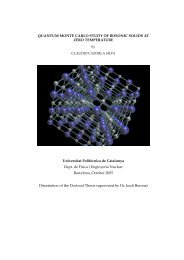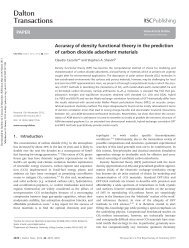Journal of Low Temperature Physics 171, 619 - DR. CLAUDIO ...
Journal of Low Temperature Physics 171, 619 - DR. CLAUDIO ...
Journal of Low Temperature Physics 171, 619 - DR. CLAUDIO ...
Create successful ePaper yourself
Turn your PDF publications into a flip-book with our unique Google optimized e-Paper software.
J<strong>Low</strong>TempPhys<br />
Table 1 Energies per particle at the ground state (E √ 3× √ 3<br />
), compared to the energies <strong>of</strong> the liquid<br />
phases at the same density (E liquid ) for the three types <strong>of</strong> graphane. The result for the same structure on<br />
graphene is also shown for comparison [7]. In the solid structures, the error bars are the ones derived from<br />
the Diffusion Monte Carlo calculation, since these structures are produced at a single density. On the other<br />
hand, the uncertainties in the liquid densities derive from four order polynomial fits to obtain the minimum<br />
point in a energy versus density representation<br />
E √ 3× √ 3 /K<br />
E liquid/ K<br />
C-graphane −401.180 ± 0.005 −397 ± 1<br />
B-graphane −407.09 ± 0.01 −404.3 ± 0.7<br />
W-graphane −414.140 ± 0.005 −406.9 ± 0.2<br />
Graphene [7] −461.12 ± 0.01 −451.88 ± 0.03 a<br />
a Energy per H 2 molecule for the liquid phase at the equilibrium density ρ 0 = (0.05948 ± 0.00005) Å<br />
Table 2 Stable phases and densities at which the phase transitions occur<br />
Phase<br />
Density/Å −2<br />
C-graphane<br />
B-graphane<br />
W-graphane<br />
√ √<br />
3 × 3 0.0600<br />
δ 0.0743<br />
incommensurate 0.081<br />
√ √<br />
3 × 3 0.0615<br />
δ 0.0762<br />
commensurate 0.0922<br />
incommensurate 0.1032<br />
√ √<br />
3 × 3 0.0674<br />
incommensurate 0.0719<br />
In the case <strong>of</strong> H 2 adsorbed on B-graphane and W-graphane, our results also show<br />
that the lowest energy per particle in both cases corresponds to √ 3 × √ 3 commensurate<br />
solid (see Table 1). In B-graphane (see Table 2), there is also a phase transition<br />
from a √ 3 × √ 3toaδ phase, in a similar way to what happens on C-graphane.<br />
However, an increase in the hydrogen density does not produce a triangular incommensurate<br />
solid right away, but another stable commensurate structure. This is a novel<br />
arrangement, whose layout is displayed in Fig. 3. There, we show the projection <strong>of</strong><br />
the positions on the z = 0 plane <strong>of</strong> 300 H 2 configurations (each one containing a set <strong>of</strong><br />
(x, y) coordinates taken from our simulations) on the B-graphane. Those projections<br />
produce the splotches displayed in Fig. 3, while the circles are the (x, y) coordinates<br />
<strong>of</strong> the C atoms <strong>of</strong> the graphane skeleton. The hydrogen atoms bound to those carbon<br />
atoms were not displayed for simplicity. We can see then that in this new structure,<br />
the H 2 molecules are located in between two <strong>of</strong> the carbon atoms whose C–H bonds<br />
point upwards. Since those positions are not isotropically distributed, the pair distribution<br />
function for this arrangement, displayed in Fig. 2, shows a set <strong>of</strong> two peaked<br />
maxima instead <strong>of</strong> the regular structures characteristic <strong>of</strong> a liquid phase.





